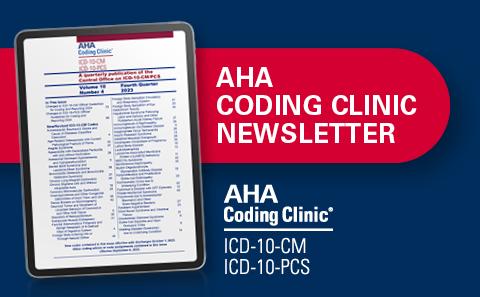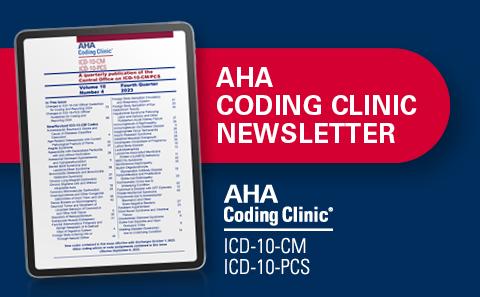
What Is in the AHA’s Coding Clinic Fourth Quarter 2025 Release for ICD-10-CM and ICD-10-PCS?
ICD-10; ICD; medical coding; q2; 2025; Coding Clinic

8 min read
The Fourth Quarter 2025 newsletter of AHA Coding Clinic for ICD-10-CM and ICD-10-PCS was released October 1, 2025. Let’s explore some of the highlights!
FY2026 ICD-10-CM and ICD-10-PCS Code Updates
The newsletter is 100 pages long and starts with the changes to the ICD-10-CM and ICD-10-PCS Official Guidelines for Coding and Reporting 2026. It includes a summary of the Fiscal Year 2026 (FY 2026) ICD-10-CM and ICD-10-PCS changes, which go into effect on October 1, 2025.
New and Revised ICD-10-CM Codes
There are 487 new ICD-10-CM codes for the FY 2026 ICD-10-CM code updates. There were 38 revisions and 28 codes were deleted from the classification. The new and revised codes in the following 36 topics are described in the newsletter:
- Demodex Blepharitis
- Malignant Inflammatory Neoplasm of Breast
- Leukocyte Adhesion Deficiency
- Type 2 Diabetes Mellitus without Complications, In Remission
- Hyperoxaluria
- Familial Hypercholesterolemia
- Disorders of Pyrophosphate Metabolism
- Lipodystrophy
- Primary Progressive Apraxia of Speech
- Relapsing-Remitting Multiple Sclerosis
- Limb Girdle Muscular Dystrophies (LGMD) Subtype 21/R9
- Other Inflammation of Eyelid
- Thyroid Orbitopathy
- Neovascular Glaucoma
- Fontan Circulation
- Cutaneous Abscess, Furuncle, Cellulitis, and Acute Lymphangitis of Flank
- Non-pressure Chronic Ulcers of the Skin by Site and Severity
- Abnormal Rheumatoid Factor or Anti-citrullinated Protein Antibody with and without Rheumatoid Arthritis
- Nephritic or Nephrotic Syndrome with Idiopathic and Secondary Immune Membranoproliferative Glomerulonephritis, and Hereditary Nephropathy
- Hao-Fountain Syndrome
- CTNNB1 Syndrome
- Kabuki Syndrome
- Usher Syndrome
- Genetic Disorders, Not Elsewhere Classified (QA0)
- Abdominal and Pelvic Pain
- Cannabinoid Hyperemesis Syndrome
- Costovertebral Tenderness
- Superficial Injuries, Open Wound, Laceration, Puncture, and Open Bite of the Flank
- Poisoning, Adverse Effect, and Underdosing of Fluoroquinolones
- Xylazine Toxicity
- Effects of War Theater
- Anaphylactic Reaction and Other Adverse Food Reactions to Milk and Dairy Products and Eggs
- External Cause of Injury Codes for Other Sharp Object Entering in or Through a Natural Orifice and Fishing Hook Entering Through Skin
- Blast Overpressure
- External Cause of Injury Codes for Other Outdoor Activity
- Z Codes Update
New and Revised ICD-10-PCS Codes
The FY 2026 ICD-10-PCS updates, including the complete list of ICD-10-PCS code titles, addenda, and a conversion table showing changes from the previous year are available on the Centers for Medicare & Medicaid Services (CMS) website.
There are 156 new ICD-10-PCS codes. There were no revised code titles, and 27 codes were deleted from the classification. The newsletter includes additional details on the following sections:
- Section 0 – Medical and Surgical
- Stereotactic-aided Intraprocedural Neuronavigation System
- Removal and Revision of Devices in Dura and Spinal Meninges
- Insertion of Endovascular Anchors
- Bypass from the Innominate Artery
- Transfer of Vascularized Nasal Tissue
- Cricothyroidotomy
- Bypass Common Bile Duct to Duodenum
- Shoulder Arthroplasty Using the Subscapularis-Sparing Technique
- Replacement of Medial and Lateral Meniscus
- Section 5—Extracorporeal or Systemic Assistance and Performance
- Extracorporeal Circulatory Filtration
- Section 6—Extracorporeal or Systemic Therapies
- Intraoperative Donor Organ Protection in Renal Transplantation
- Section 8—Other Procedures
- Morphological Structure Analysis System
- Section F—Physical Rehabilitation and Diagnostic Audiology
- Negative Pressure Wound Therapy (NPWT)
- Section X—New Technology
- Radiofrequency Ablation of Cardiac Plexus
- Ultrasound Ablation of Brain
- Dilation Using Expandable Intraluminal Device with Growth Technology
- Dilation of Arteriovenous Fistula with Cell Impermeable Endoprosthesis
- Division of Aortic Valve Leaflets Using Radiofrequency Energy
- Dilation of Carotid Artery with Integrated Embolic Protection
- Insertion of Volume Sensor Management Device
- Temporary Transvenous Diaphragm Activation
- Insertion of Implantable Endocardiac Pacing System
- Insertion of Temporary Retrievable Intraluminal Device
- Restriction of Thoracic Aorta with Hybrid Intraluminal Device
- Inspection of Upper Gastrointestinal Tract Using Ingestible Wireless Capsule
- Sacroiliac Joint Fusion/Pelvic Fracture Fixation with Threaded Implant System
- Cervical Spinal Fusion with Custom-Made Anatomically Designed Interbody Fusion Device
- Insertion of Posterior Cervicothoracic Spinal Stabilization System
- Introduction of New Therapeutic Substances
- Introduction of Peptide Enhanced Bone Void Filler in Transforaminal Lumbar Interbody Fusion Procedures
- Transfusion of New Therapeutic Substances
- Continuous Glucose Monitoring
- Extracorporeal Pheresis of Ticagrelor
- Gene Expression Testing System for Whole Blood Samples
- Quantitative Analysis of Human Milk Macronutrient Content
- Computer-aided Triage and Notification Software for Measurement of Biomarkers
Changes to the ICD-10-CM and ICD-10-PCS Coding Guidelines
A summary of the modifications to the ICD-10-CM and ICD-10-PCS Coding Guidelines is included in the fourth quarter newsletter. Some of the changes include new information on the following:
- The meaning of commas in the Alphabetic Index
- Coding multiple sites
- Selection and sequencing of HIV codes
- Type 2 diabetes mellitus in remission
- Prophylactic organ removal
- New examples on coding multiple procedures in the New Technology section
The complete guidelines may be downloaded from the CDC’s website.
Ask the Editor
The newsletter includes 10 question and answers addressing the following topics:
- Malignant Inflammatory Neoplasm of Breast
- Type 2 Diabetes Mellitus without Complications, In Remission
- Abdominal and Pelvic Pain
- Cannabinoid Hyperemesis Syndrome
- Xylazine Toxicity
- Negative Pressure Wound Therapy (NPWT)
- Ultrasound Ablation of Brain
- Biliary Drainage Using the AXIOS™ Stent
Terms to Know
Review the following terms to help understand the fourth quarter newsletter. These are just a subset of the terms defined in this quarter’s release; please review the newsletter in its entirety for a better understanding of the newly classified diseases.
TERM | DEFINITION |
|---|---|
| Familial hypercholesterolemia | Inherited genetic disorder that interferes with the body’s ability to remove low-density lipoprotein cholesterol (LDL-C), the “bad cholesterol,” from the blood |
| Heterozygous familial hypercholesterolemia (HeFH) | Occurs when an individual inherits the variant (mutated gene) from one parent; HeFH is the most common type of hypercholesterolemia |
| Homozygous familial hypercholesterolemia (HoFH) | Occurs when an individual inherits the variant gene from both parents |
| Ectonucleotide pyrophosphatase/phosphodiesterase 1 (ENPP1) | Protein involved in the production of pyrophosphate, which is important in preventing the accumulation of abnormal deposits of calcium and other minerals in the body |
| Lipodystrophy | A loss of body fat in certain areas of the body, while collecting and storing fat in other areas |
| Fluoroquinolones (FQs) | A broad spectrum of systemic antibacterial agents, that are widely used as therapeutic treatment for respiratory and urinary tract infections, as well as other bacterial diseases of the eyes, skin, and lungs |
| War theater | The entire land, sea, and air area that is or may become involved directly in war operations |
As always, please read the Fourth Quarter 2025 AHA Coding Clinic for ICD-10-CM and ICD-10-PCS entirely for the best source of medical coding information to apply to professional coding.
